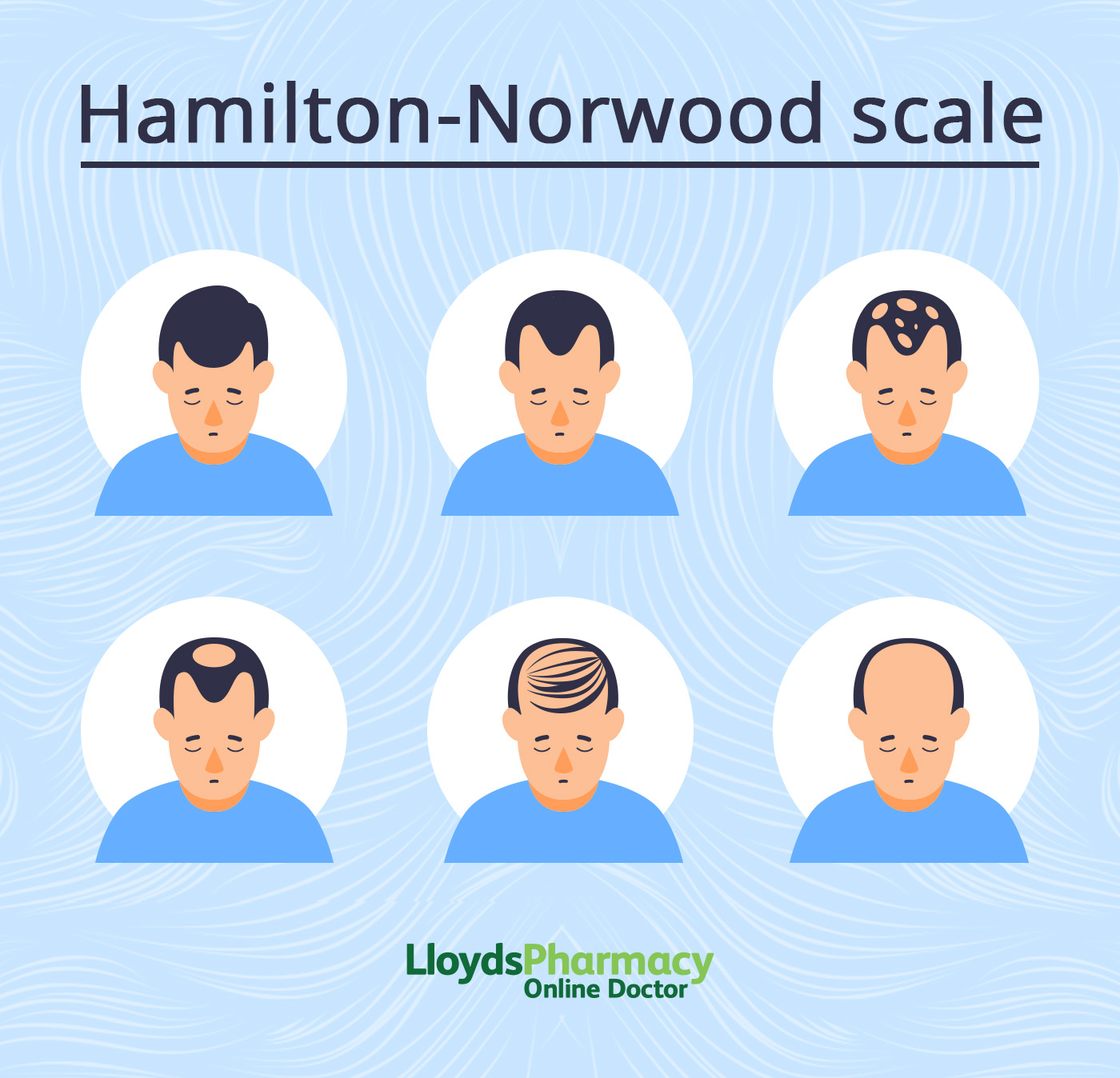Why do I have a receding hairline?
- How to spot hair loss early
- Why hair loss happens
- How many men are worried about hair loss
- Causes of a receding hairline
- How is a receding hairline diagnosed?
- How is a receding hairline diagnosed?
- Myths about receding hairlines
- How to deal with a receding hair line
- Treatments for a receding hairline
Reviewed by Dr Neel Patel
How to spot hair loss early
A receding hairline or partial baldness can seem especially distressing in this hair-obsessed world. However, hair loss is a common condition, and is usually a natural part of growing older. This article looks at the cause of receding hairlines, how hair growth works, and effective treatment options.
Why hair loss happens
To understand hair loss, it’s first important to understand that head hair is different to hair found on the rest of your body. There are between two and five hairs for each pore on your head which grow from clusters of hair follicles. Each cluster has a ‘primary’ hair and ‘secondary’ hairs.
These hairs grow for two to six weeks at a time (the anagen phase), then transition to a period of rest for five to six weeks (the telogen phase). Once follicles move back to the anagen phase, the ‘resting’ hair is pushed out, resulting in hair loss.
Whilst this process is entirely ‘normal’, it becomes slightly altered for those with hair loss:
- Hair follicles shrink and stop producing secondary hairs, leading to thinner hair
- The telogen phase increases, leading to greater shedding of hair
- The anagen growth phase becomes shorter, limiting the opportunity for regrowth.
Once the primary hair is lost, a bald patch starts to appear.
How many men are worried about hair loss
In a survey of 500 UK men, we found that almost half (48%) are actively worried about potential hair loss and balding with those aged between 25 and 34 the most worried at 67%.
Over half, 56% also admitted that any hair loss or balding would negatively affect their personal confidence or self-esteem.
As for dealing with hair loss, 20% would seek out a prescribed treatment whereas 27% would opt for a complete hair transplant.
UK search queries for hair loss
Looking at Google data, UK searches for ‘hair loss’ have increased by 21% year-on-year from 2023 to 2024 now averaging 144,000 searches annually.
Search Query | Annual Searches | Increase 2023-2024 |
| Hair loss | 144,000 | 21% |
| Receding hairline | 172,000 | 18% |
| How to stop receding hairline | 24,000 | 17% |
| How to stop hair loss | 25,000 | 11% |
Similarly, UK searches for ‘receding hairline’ have also increased by 18% year-on-year, now averaging 172,000 searches each year. Searches for how to stop these have also increased.
As more people turn to treatments, another stat the data highlighted was the decrease in searches for ‘hair transplants’. UK-specific queries decreased by -41% year-on-year with Turkey-specific ones seeing a -17% decrease.
Causes of a receding hairline
So now we know the process that can cause hair loss, it’s worth looking at what might trigger this process, as there a variety of different types of hair loss.
Male pattern baldness
Male pattern baldness is the most common form of hair loss. The term ‘pattern’ comes from the pattern hair loss tends to follow, starting from one of three distinct areas of the scalp: the temples, crown, or mid-frontal area.
The hair loss happens when the hair follicles start converting testosterone into another hormone called dihydrotestosterone (DHT). This disrupts the natural hair growth cycle, causing the hair follicles to shrink.
This type of hair loss is usually down the genetics.
Alopecia
Alopecia is a more general term for hair loss. Alopecia areata is a specific type of hair loss, that tends to cause patchy hair thinning or hair loss. It can lead to well defined bald patches across the scalp.
Alopecia is thought to be an autoimmune condition. Certain cells from the immune system start gathering around hair follicles, attacking them and disrupting the natural cycle of hair growth.
Increased age
In the case of male pattern baldness, you could say that age is a factor in a receding hair loss. For lots of men, male pattern baldness is a natural part of ageing. With the condition affecting around half of all men by the age of 50.
But that doesn’t stop it affecting younger men too. Find out more about hair loss in young people here.
How is a receding hairline diagnosed?
The Noorwood Scale is used by medical professionals to classify male pattern baldness and has seven different stages. It looks at the pattern of hair loss as well as how much hair has been lost.
The Hamilton-Norwood scale

Stage 1: At this stage, there is no hair loss or hairline recession. This is the stage which all others are compared against.
Stage 2: During this stage, the hairline will have begun to recede slightly – usually starting around the temples. This is known as an adult or mature hairline and is not classed as male pattern baldness just yet – rather the hairline is changing from a teenage to adult shape.
Stage 3: This is the first stage where notable signs of hair loss appear and is classified as the first stage of balding. The hairline typically recedes further to resemble an M, U, or V shape with the recessed spots completely bare from hair.
Stage 3 Vertex: This is a variation of stage 3 where the hairline remains as it did in stage 2 but thinning and balding instead appear on top of the scalp (the vertex). This is otherwise known as a bald spot.
Stage 4: At this stage the bald spot on the scalp gets bigger with little to no hair left on the vertex. The front hairline also continues to recede creating a strip of remaining hair across the middle of the scalp.
Stage 5: This stage is similar to stage 4 however the strip of remaining hair between the two bald areas is narrower and sparser.
Stage 6: At this stage, the two bald areas join up covering the top of the head. Now only the hair around the sides of the head remains.
Stage 7: This is the final stage where the remaining hair around the sides begins to be lost as it gradually becomes thinner and finer.
Norwood Class A: This is a variation of the traditional scale where the hairline recedes uniformly without leaving a bald patch on the vertex. Instead, the hairlines progressively recedes directly from front to back.
How is a receding hairline diagnosed?
The Noorwood Scale demonstrates the progression of each of these three patterns of hair loss. For more information, see our doctors’ article on male pattern baldness.
Myths about receding hairlines
Just to clear up a few myths, cutting your hair will not encourage it to grow any quicker, massaging your head to increase circulation won’t affect hair growth, and excessive amounts of sex will not lead to hair loss.
How to deal with a receding hair line
Outside of treatment, there are few things you can do to stop a receding hairline.
Changing your lifestyle will not work if male pattern baldness is the cause of your hair loss. Whilst some men experience temporary hair loss due to stress, illness, certain medications, and dietary deficiencies, the most common cause of receding hairlines is embedded in your genetic make-up and can’t be ‘cured’.
Hairstyles for a receding hairline
If you’re conscious of your receding hairline, there are a variety of different hairstyles you can try. From mop tops to crew cuts and growing facial hair, there’s lots of styles that can make the most of the hair you have.
It’s also a good idea to avoid things like tight top knots or braids, as this might end up weakening and pulling on the hair roots.
Find out more about hairstyles for hair loss here.
Treatments for a receding hairline
Prescription treatments
Prescription treatments like Propecia and its generic form Finasteride can help reduce hair loss. Finasteride has the same active ingredient as Propecia. Up to 90% of men who use it seen an improvement, whilst two-thirds benefit from renewed hair growth. However, since there is no cure for hair loss, any positive results will only last for as long as treatment is taken. These treatments are only suitable for men.
Over-the-counter lotions and shampoos
Treatments like Regaine (minoxidil), are also available and have been shown to be effective in treating male pattern hair loss. They tend to come in a lotion or foam. You can also get Regaine for women, so this is an option if you're experiencing female pattern hair loss.
Hair transplants
While they’re not for everyone, hair transplants can also be effective in treating hair loss. Following this procedure, hairs resistant to hair loss (usually found at the back of the head) are relocated to bald patches. This can be a very effective counterweight to hair loss, although success rates can vary dramatically.
Wigs and hair pieces
For those looking for a less invasive alternative, a flourishing industry of hair pieces and wigs exists. Better still, embrace hair loss as a natural part of the ageing process and save yourself a lot of effort!
References
https://patient.info/mens-health/male-pattern-baldness
https://www.sciencedirect.com/science/article/pii/S0022202X15529357
https://www.ncbi.nlm.nih.gov/pmc/articles/PMC4812885/





